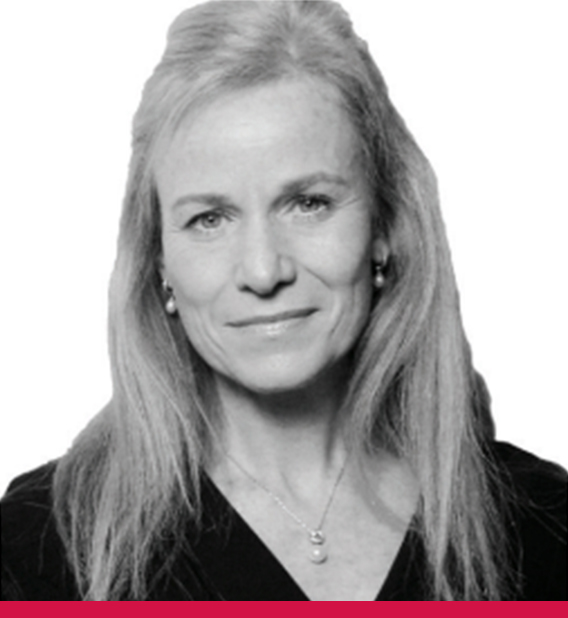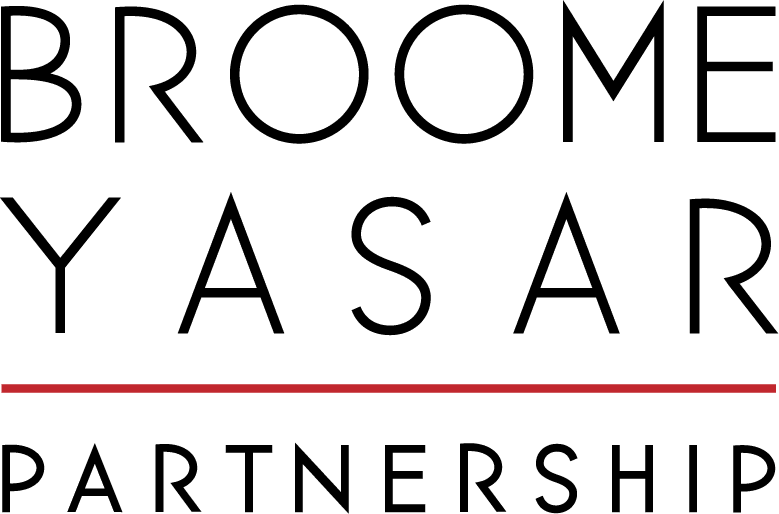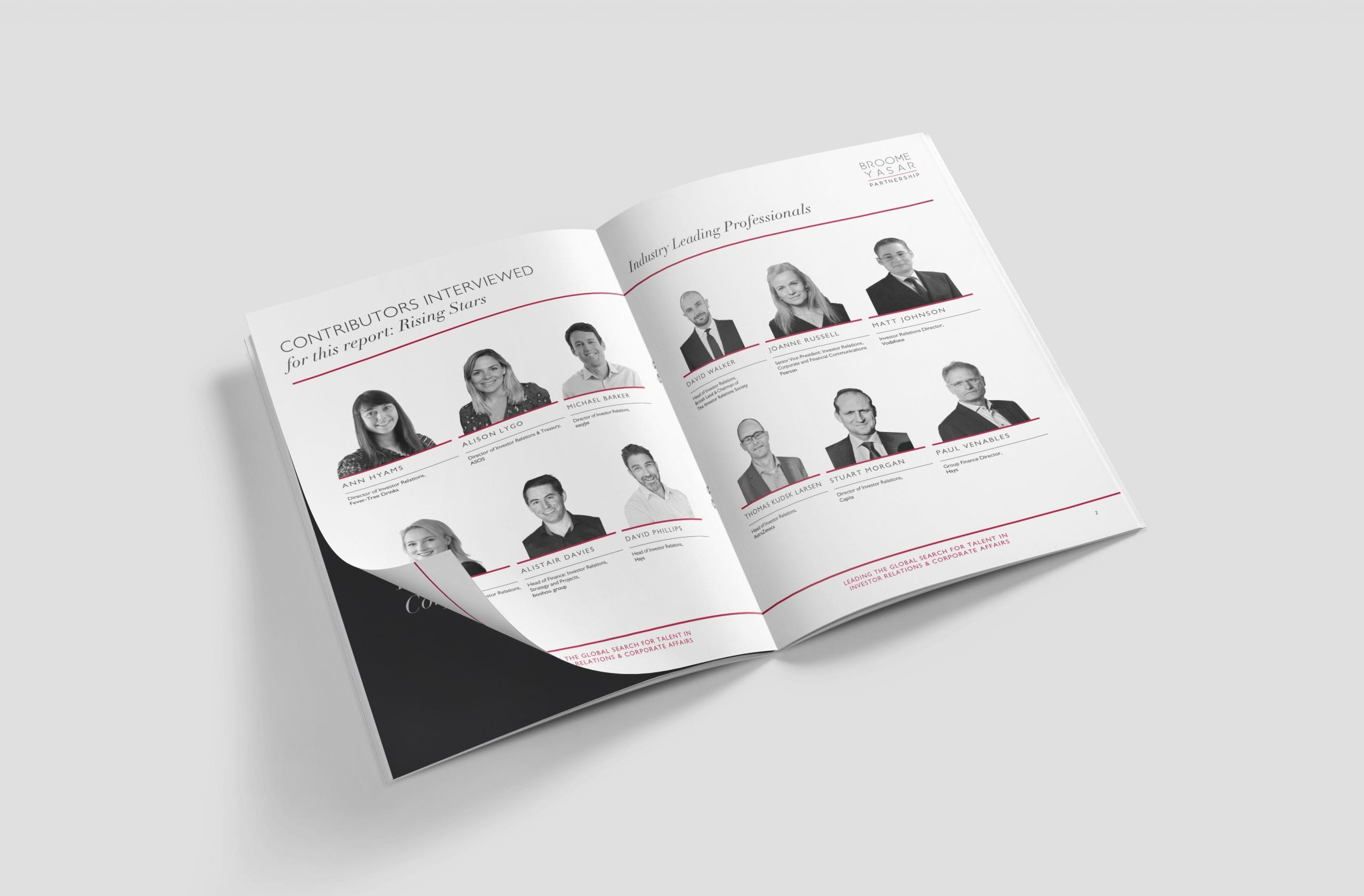INSIGHTS
RISING STARS IN INVESTOR RELATIONS STAND OUT OR STAND ASIDE
Key building blocks to becoming a Standout IRO
Download full PDF version of the report
DownloadInterviews with industry leading professionals & rising stars
CONTRIBUTORS INTERVIEWED
for this Report: Rising Stars

ANN HYAMS

ALISON LYGO

MICHAEL BARKER

EVELYNE BULL

ALISTAIR DAVIES

DAVID PHILLIPS
Industry Leading Professionals

DAVID WALKER

JOANNE RUSSELL

MATT JOHNSON

THOMAS KUDSK LARSEN

STUART MORGAN

PAUL VENABLES
FORWORD
THE NEW WORLD IN INVESTOR RELATIONS STAND OUT OR STAND ASIDE
THESE ARE EXTRAORDINARY TIMES FOR THE INVESTOR RELATIONS PROFESSION. THE ONCE-IN-100-YEARS COVID-19 PANDEMIC IS AFFECTING EVERY ORGANISATION IN EVERY SECTOR OF THE GLOBAL ECONOMY. WAYS OF WORKING THAT WERE ONCE UNTHINKABLE ARE NOW REALITY AND SOME OF THEM MAY BE HERE TO STAY. IT IS PRESENTLY UNCLEAR WHICH OF THE MANY CHANGES WE ARE EXPERIENCING WILL BE TEMPORARY AND WHICH WILL BE PART OF A PERMANENT “NEW NORMAL”
This external geopolitical and macroeconomic backdrop is also playing out at what is already a time of seismic change for the investor relations function. The ever-present quest for growth in mature markets is combining with pressure from new regulations as well as the significant impact on corporates from the increasing focus on organisations’ social and environmental footprints through ESG, making IR more pivotal than ever in its role at the centre of company strategy and communications.
Today’s diverse, confident, experienced and more sophisticated range of IROs is helping organisations deal with these unprecedented challenges. CEOs and CFOs are under enormous pressure in the current climate of market uncertainty, with many realising that their own careers, as well as the fortunes of their companies, depend greatly upon how they communicate with their varied stakeholders. With regulation and investor activism taking up more of their energies, they will lean ever more heavily on their IROs to satisfy stakeholders’ need for relevant, accurate and speedy information.
As investor relations changes, so does its major players. At Broome Yasar, we have watched for many years the development and progress of a talented cadre of new investor relations professionals, helping them to make career decisions and their companies aware of their potential. Out of nearly 400 senior level appointments we have helped to make over the past 15 years, we have seen the rise of a more sophisticated, ambitious and forward thinking IRO. Similarly, we are also thrilled to see so many making the transition into important broader business leadership roles, as highlighted in our ground-breaking report, “From IR to Business Leader, the Pathway to CEO?”, which was published also in association with the IR Society. What is clear is the difficulties brought by the current environment needs a new and different way of thinking with fresh ideas. Those same challenges will also further hone and shape this new generation of IR leaders.
Sector and industry transformation bring challenges for companies and their IR departments alike. What different skills are required and needed to solve new problems and address evolving trends? What do changing external and internal environments mean for this next generation of investor relations executives?
How do they view their journeys into and through the industry and beyond? And how might their career trajectory develop and change as they plot their way through the challenges of managing and extending their personal and professional individual brands?
To deepen industry understanding of these and other questions, Broome Yasar has conducted in-depth interviews with a number of high-profile IR professionals who we have identified as rising stars. To help them and other ambitious movers and shakers in the sector, we also captured the insights of several established senior heads of the function at some of our major companies, as well as from leading CFOs and the leadership of the IR Society. Along with these detailed interviews, Broome Yasar also conducted the industry’s biggest ever survey of IROs and their career objectives, with more than 200 survey responses garnered.
The result is a fascinating pointer for executive boards, IR & HR departments, as well as the many other ambitious and talented professionals in the sector to consider as they shape themselves for the challenges ahead. The rising stars we have identified in this report are but a small sample of the talent coming through investor relations departments in both the UK and rest of the world.
In showcasing these brilliant IROs, we hope to inform and encourage others, whilst also helping to foster a continuing conversation around the industry’s evolution and the skills it will need to achieve its full potential.

LAURA HAYTER
CHIEF EXECUTIVE, THE INVESTOR RELATIONS SOCIETY
Preface: The growing influence of the profession will continue to strengthen
Much has changed since I began my career in investor relations and it’s hard to predict anything other than continued transformation in the years ahead. Before the pandemic, investor relations was growing rapidly in importance and size and proving increasingly invaluable to CEOs, CFOs and the board. The new questions being asked of all companies in the time of Covid-19 mean that the remit of the IR role is becoming even wider.
This may not be a temporary effect. The Investor Relations Society believes that the influence of the profession will continue to grow. A tide of new regulation in the wake of the 2008 financial crisis has increased scrutiny over issues including disclosure, market abuse and insider dealing. Simultaneously, the increasing demands of stakeholders and governments on environmental, social and governance (ESG) continue to challenge corporates, and this is helping IR become even more essential to the C-suite.
As we celebrate our organisation’s 40th anniversary it is worth reflecting on the changes that have shaped our profession, and its importance in promoting trust and integrity in financial markets. Successful IROs need a much broader skillset and increasingly move into the profession with investment banking, accounting, corporate finance or communications backgrounds.
A significant number in our industry have taken The IR Society’s Certificate in IR (CIR®) qualification, which has become a benchmark in the industry, widely recognised in the UK and in other international markets. It is a comprehensive, stretching test of your competency in IR, providing the tools to help you develop your career in the profession.
Our professionals need to be able to demonstrate an excellent understanding of financials and be able to articulate a compelling narrative of long-term value creation. They need to be team players and innovators.
MiFID II has had a profound change on the industry since its implementation in 2018, resulting in companies communicating more directly with their shareholders. That has brought new entrants into the profession from the sell-side and greatly widened the scope of IR departments.
The IR industry depends on a fresh and vibrant stream of new talent with the training, character and broad skillsets to continue to push the boundaries in IR. The Society is therefore delighted to be partnering with Broome Yasar for this report, highlighting the profession’s changing mix of talent and skills and signalling what’s needed on the road ahead. It’s my hope that all in the industry will continue to place high importance on their professional development. Our organisations need you more than ever.
NEW DYNAMICS, RISING STARS
What are the dominant qualities of the new breed of rising star investor relations officers? They’re certainly different from many of their predecessors in the role. Whereas some members of previous IR generations admit to “falling into the career”, heads of IR born around the same time the IR Society was founded in 1980 tend to have targeted the profession strategically. They frequently have banking or financial industry training and may well be looking beyond IR as an eventual career destination. We interviewed a number of highly acclaimed rising stars in investor relations, many of whom Broome Yasar had had the privilege of helping to place and we are delighted to showcase their career trajectory and their own assessment of their ambition.
Evelyne Bull, Vice-President Director, Investor Relations, at global information services group Experian, is typical of the new breed, joining BT Group from Oxford University, working as a finance analyst for three years before spending seven years as senior investor relations officer. “I find it a privilege to work in IR,” she says, “because you have access to information and senior people that many people across the business would give their right arm for. It’s really exciting to have all this confidential information and to be behind the scenes of a big corporate move that the company is going to make. It’s a unique role from that perspective.”
Similarly, Alistair Davies, Head of Finance: Investor Relations, Strategy and Projects at online fashion group boohoo Group, moved over to IR after an accountancy training and seven years as a retail analyst for Oriel Securities and Investec. A move which more than 30% of those questioned in our industry study had also successfully made. After a decade analysing companies, he says he wanted to use that experience in-house and joined boohoo. “I’d always been on the outside looking in,” he says. “I felt I was at a point where I wanted to put the background and experience that I had to good use in a business.”
The financial experience that investor relations professionals need does not necessarily have to come from having worked for a bank or financial services company. Australian Michael Barker, Director of Investor Relations at easyJet, trained as an accountant before spending 11 years as a senior finance analyst at car manufacturer Ford. He moved to the UK in 2012, joining easyJet at first as a Regulation Manager at Gatwick Airport. “I enjoyed working with numbers, but I wanted to try a different industry and see what happened,” he says.
After nearly two years in the regulatory team, he switched to IR, spending six years as a Senior IR Manager before becoming Head of Investor Relations and then taking over as Investor Relations Director, one of the youngest IROs to do so. “The past year has involved the most experience that I think anyone can get as a new head of IR,” he says, referring to the huge impact that Covid has had on the aviation sector. “It’s been a very interesting time. After being offered the role, almost every week since then we were making some kind of announcement.”
For some a business training is as good as a financial background. Another illustration that entering the IR profession can come from a multitude of backgrounds is Ann Hyams, Director of Investor Relations at premium mixer brand Fever-Tree, who started her career as a strategy consultant at L.E.K. Consulting, before moving to Whitbread as a commercial strategy analyst. From there, she moved into IR, first as an analyst and later as a manager before becoming Head of Investor Relations and then moving to Fever-Tree.
“The more I learnt about what the role entails, both externally, managing market perceptions and interacting with shareholders, and internally with the board and management team, the more it appealed to me,” she says. “I’d already been at the company in a strategy role for a couple of years, so I was familiar with the business, but not with financial markets and how companies interact with them. I learnt quickly and was allowed to take on more responsibility at a fast pace which kept the role exciting and varied.”
There’s still room for some old-fashioned serendipity, however. Alison Lygo, Director of Treasury and Investor Relations at online fashion retailer ASOS, is well-qualified for IR, having undertaken accountancy training and then treasury roles at Sainsbury’s. After joining ASOS as a senior treasury analyst and moving up twice in that department, she got her first experience of IR when she was switched to the function temporarily because the company needed some extra help around the time of its financial results. She stayed in the department, before becoming Head of Investor Relations and adding the post of Director of Treasury
“I really took to it and really enjoy it as a role,” she says. “I had always been more interested in how a business operates externally. A lot of corporate work can be very inward-looking, but Treasury and IR are the two areas where you’re looking at how a business positions itself externally, whether in equities or the foreign exchange markets. I feel it prepared me really well for a career in IR.”
Paul Venables, Group Finance Director at recruitment group Hays, believes that, although it’s not essential to enter IR from a financial background, numeracy is essential in order to fulfil the requirements of the role effectively. This is reflected in one of the major findings from the industry survey of 200 IROs, which highlighted that more than 50% of IROs have at least one financial qualification – ACA, CFA, CIMA, with at least 10% having an MBA. “You’ve got to have a very good understanding of your company’s numbers and its trading,” he says, “but you’ve also got to understand it from the perspective of an analyst writing a note and seeking to answer shareholders’ questions. You’ve got to understand the numbers intuitively and be able to give clear steers and messaging.”
ADVICE FROM THE TOP
SENIOR, EXPERIENCED INVESTOR RELATIONS OFFICERS OFTEN HAVE AN INTERESTING TALE ABOUT HOW THEY ENDED UP IN THE SECTOR.
We also interviewed several well established and award winning ‘stars’ in their own right, for this study to help others to visualise how they can also reach similar heights with their own careers. Although there has been a fresh flow of professionals into IR since the MiFID II regulations were brought into force, it was already a well-trodden route. Matt Johnson, Investor Relations Director at Vodafone Group, is one senior example, switching first to a corporate strategy role at Australia’s Coles Group after eight years in corporate finance at KPMG and Deloitte, working on a total of 120 transactions. He added investor relations to his portfolio and then progressed to Investor Relations Director at builders’ merchant Travis Perkins and Whitbread before moving to Vodafone as its Director of IR.
“My boss at Coles asked me if I would also like to look after IR, given my understanding of the capital markets,” he recalls. “Me moving into IR was definitely an accident, but I started to like it. I didn’t see myself as a career IR person but I’m now doing my third investor relations job.”
At Travis Perkins, in his first full-time IR role, the company had not had a head of IR before. “It was a challenge,” says Johnson. “I had to draw up my own job description. The company didn’t really have a view of what IR should be. I wanted to define it from exactly what I thought would be right for the company.”
He admits he took a much broader view of IR than is typical, utilising his personal strength to consider IR as a different kind of sales job – an approach he still takes today. “In my experience as a corporate financier, all I had ever done was to sell companies, whether through an IPO, debt or a mergers and acquisitions transaction,” he says. “That was my skill-set, so I took a corporate finance discipline and applied it to investor relations. My approach is to define why somebody should buy a share in my company and then actively market it in the same way as I would do if I was selling a company directly.”
Thomas Kudsk Larsen, Head of Investor Relations at AstraZeneca, believes a corporate route into IR is just as valid as working for a bank. After beginning his career as a finance trainee at Danish pharmaceutical firm Novo Nordisk in 1995, he moved through financial disciplines and was later a member of the team that split the company into a core pharmaceutical function and the Novozymes industrial biotech operation.
“It was a big deal splitting a company that had been together for 80 years,” he says. “I got involved in that and it meant I had to deal with the shareholders and convince them that it was a good idea. I worked on helping to split the company and that gave me an appetite to do more work with banks, shareholders and analysts.”
“Compared to traditional finance, I find that I am a lot more challenged in IR,” he adds. “You are challenged in finance too but there’s a lot of routine there. You’re never faced with something like an M&A rumour that you have to reassure investors about while not being able to o er comments, our standard policy. I kind of like that you don’t really know what’s being thrown at you and you have to react to that and do your best. I think there’s that element of greater challenge and I think my mind is better suited for that. When I need to go deep into a piece of science, I can do so, but I can also go very broad and compare the pharmaceuticals sector to other industries like mining and oil exploration. I don’t think that ability is found in any other jobs.”
Joanne Russell, Senior Vice-President of Investor Relations, Corporate and Financial Communications at educational publishing group Pearson, began her career in the Royal Air Force but switched to become a research analyst at ABN AMRO after two and a half years. She then spent nine years as a managing director at JP Morgan Cazenove before moving into IR as Head of Investor Relations for Mothercare and then spending six years as Director of Investor Relations at Whitbread, before moving to Pearson. She now looks after financial communications, as well as IR, and also gets involved in communicating debt and equity issues at roadshows.
“I was lucky,” she says, “because when I went into the City in 1997, we floated the internet service provider Freeserve. It was the time of the dotcom bubble and I ended up handling 26 stock market flotations. It was a great mix of being a sell-side analyst but also doing a lot of primary work, which doesn’t exist as much today. At JP Morgan, I began to see IR as an extension of what I was already doing. I understood the City very well and had spent my life analysing and valuing companies. The difference is that I just analyse the one company now, but it is still the same tools of the trade and how you convey the growth drivers of the opportunity ahead to the financial markets. But the good thing about today’s IR career is that you get the opportunity to expand into so many different areas such as communications, ESG, debt, media etc.”
“I fell into IR, to be perfectly honest,” says Stuart Morgan, Director of Investor Relations at outsourcing group Capita and formerly Head of IR at easyJet. Morgan started at accountants PricewaterhouseCoopers before joining financial PR firm, Buchanan Communications, after seven years. He has now worked in investor relations for nearly two decades, moving through head of IR positions at biotech group Eurofins, coach operator National Express and motoring organisation RAC.
“I’ve never worked in a big IR team where you come in as a junior and slowly work your way up, working with people who’ve done it before,” he says. “I was taught a set of best practice and best principles for your approach to lead to open, transparent communications. I’ve always worked on the principle that you start from best practice and what you want to do. You need to be talking regularly to the people that you want to communicate with. Then everything else falls o the back of that.” It is this attitude and focus, we believe, which won him the award for best FTSE IRO at the IR Society’s Best Practice Awards.
THE CHANGING FACE OF INVESTOR RELATIONS
Many experienced investor relations operatives say that the sector has changed almost beyond recognition over recent decades. The scope of the role is much wider. New regulations and developing disciplines such ESG have emerged alongside IR, creating a need to be conversant with each and to have a more sophisticated approach to IR than ever before. Something the recent new entrants are becoming all too aware of and their experience prior to IR is coming to the fore.
Alistair Davies, Head of Finance: Investor Relations, Strategy and Projects, boohoo group feels that there is still no substitute for financial experience as a route into investor relations, while the breadth of the IR role is also attractive to financial professionals looking for a wider remit. “Equity research is a great career with a lot of access to senior management teams and investors,” he says. “What attracted me to IR was wanting to take that knowledge in-house, and experience how that role interplays with senior management teams and shareholders.”
“The experience I had before really gave me a unique insight when I first went into the business. It just felt like a really natural fit of understanding, having worked in the finance industry and then wanting to move in-house and trying to deliver value internally.”
Joanne Russell at Pearson also sees continued synergies between the sectors. “You write a lot of research as an analyst, so you have to have reasonably-honed communications skills,” she says. “But you also have to be able to build up relationships with the analysts and the buy side.” Additionally, David Philips of Hays, who successfully switched over to IR from equity research and won the IR Society’s Best Practice Best Newcomer Award in his first year as Head of IR, says, “You need a mix of strong analytical skills and be able to communicate complicated messages as succinctly as possible. As an IRO you get access to all parts of the business and are in a unique position to both convey and interpret information.” He concludes, “So you need a high degree of professional judgement.”
Matt Johnson at Vodafone believes that the flood of former financial analysts into investor relations has also created a problem, with some people who have taken that route neglecting the sales side of the job. “A lot of former sell-side analysts have moved into IR jobs in recent years,” he says. “But, while a sell-side analyst’s approach is to get to know the numbers in detail and they’re also very good at analysing companies, they’re not necessarily salespeople. It’s a skill-set that they have to learn, just as someone who comes into IR without a financial background simply has to learn the numbers side.”
Michael Barker at easyJet believes that accountancy training alone does not give new entrants to IR the skills that they need. “It took me a bit of time to get used to IR,” he says. “I had never had any exposure at all to markets, shareholders, banks, broking teams and analysts so the initial couple of years were about getting my head around all that. That was the biggest learning curve that I had. The skills I had to develop included the ability to build relationships with people from all areas of the investment community. That’s very important in IR. You have to help them understand what you understand about the business and help them to see the positives. This comes much easier when you have built a relationship with them. The numbers side came quite easily to me.”
David Philips of Hays thinks that even in the relatively short period that he’s worked in IR the amount of direct approaches from investors has increased, meaning “you need to have a very clear investor narrative to help capture their imagination quickly, and use many different channels to communicate.” But he says, “overall the job remains highly focused on personal relationships – with your management team and colleagues, your shareholders, your analysts and other key stakeholders. The role of IR should be about building trust between the company and all these groups.”
As investor relations departments are becoming more skewed to people with financial skills, they are also increasing in size. Laura Hayter at The Investor Relations Society, says that, while only one or two professionals comprise the IR department at many mid-sized companies, larger companies may employ between 8-10 people.
Ann Hyams at Fever-Tree Drinks believes that MiFID II regulations are having a significant impact on this, changing the way sell-side financial analysts interact with investors and promoting the IR profession more by encouraging increased in-house capability. “I think IR teams will become larger as companies see the value of doing more things internally, rather than outsourcing them,” she says. “There will also be a lot more IR time, and potentially more IR professionals dedicated to environmental and social governance as sustainability and governance play a greater role in how companies operate and in investment decisions.”
Paul Venables, Group Finance Director at Hays, is a great believer in the value of well-trained, high-quality investor relations professionals. He believes that, alongside their professional knowledge, they need to possess some essential personal attributes. “Integrity and knowledge are incredibly important,” he says.
“To be credible, you have to have knowledge of the business and its drivers and good relationships throughout the company to really understand what goes on. You also need to be calm under pressure and resilient, especially when you’re under attack. If you stay at a company for any length of time, there will be difficult periods when your company is under attack or has underperformed.”
Ann Hyams believes IR requires a “unique combination” of analytical ability, strategic awareness and strong interpersonal skills. “Getting involved in different areas of the business is a great way to make the best of the opportunities and help you to decide how you want your career to progress in the future,” she says. “Using the IR role as a launchpad into internal projects will broaden your horizons, teach you new skills, enable you to learn more about the business, and widen your internal network.”
She recommends starting with the basics of IR but then quickly looking to increase your remit naturally and take on more responsibility. “It’s always been my goal to take on as much responsibility as I can at any particular time and stretch myself to reach the next level,” she says. “Something that’s always resonated with me is to not be too afraid to fail early on in your career, as long as you learn from your mistakes and recover quickly.”
Stuart Morgan at Capita believes that there’s no substitute for experience: “The longer you stay at a company, the better you can be at understanding it and bringing those years of experience to investors and analysts” he says. “People tend to start o on the back foot when they start in an IR job, with people telling them about the company and what it’s done in the past. The longer you’re in that role, the more you can contribute and push back, standing toe to toe with them.”
POWER IR, WHERE NEXT….?
IR is now seen as a significant career platform by many of these IR professionals and this is reflected in the fact that nearly 50% of the 200+ IR professionals interviewed for the survey had stated that within the next five to 10 years they see themselves in a different role internally, with at least 20% stating they are keen to move into a CFO role. However, nearly 50% of those responses stated that they were keen to remain in investor relations over the next 10 years, providing the industry with an incredibly strong talent pool.
“The question that investor relations grapples with more than any other profession is whether IR should be an end in itself or a stepping-stone on the way to loftier ambitions,” says David Walker, Head of Investor Relations at British Land, and Chairman of the Investor Relations Society.
When he started in IR ten years ago, he says it was very much viewed as somewhere that high potential, high-performing people would spend time to build a deep understanding of their business. While they were there, they could get to know the executive management and board and develop their exposure in such a way that they could be moved into more senior management positions, including the finance director role in some cases. Despite this, relatively few IR professionals became finance directors and only a very small handful acceded to the chief executive’s role.
That’s a path that’s coming under fresh scrutiny, but Walker says investor relations is also a perfectly good place to stay for an entire career, as long as you are constantly progressing and learning new skills. “Over time, as the professionalism of the role and the quality of people in it have increased, it’s increasingly seen as an aspiration and an end in itself,” he says. “You’ve started to see far more research analysts and investment banking professionals proactively take the decision to move across into heads of IR roles at big companies and not necessarily with the intention to use it as a stepping-stone. That’s a good thing but it doesn’t mean that it isn’t a place where you can really develop and learn and move on from.”
Indeed, Alison Lygo at ASOS has already added Head of Treasury to her IR role after discussing her career trajectory with her Chief Financial Officer once she had been in the position for eighteen months. “We discussed how I would build a path to becoming finance director and broadening my current role and experience. I wasn’t ready to step away from IR, but wanted to continue broadening my skill set, so we agreed I would take on heading up the treasury team too.” Lygo ended up adding the treasury role just a few weeks before the Covid-19 pandemic began in the UK.
David Philips of Hays absolutely believes the best IRO’s are strong all-rounders and that “the role presents lots of opportunities for special projects work, which is a great stepping-stone into operational and executive management.”
Evelyne Bull at Experian believes that IR professionals should not be afraid to switch in and out of the sector during their careers. She moved out of IR at the beginning of 2018, working as a business manager to the Chief Executive of BT’s consumer brands for five months before an eight-month stint as Head of Strategy in the consumer division, before moving back into IR at Experian in 2019. “BT was a great place to learn IR,” she says, “because it’s a very high-profile company that’s always in the public eye and it has a complex set of stakeholders with conflicting needs. Most companies’ stakeholders are shareholders, employees, customers, suppliers, the general public and the media. But BT also had its pension trustees, regulator and the Government. There were a lot of people to take into account when crafting a message or deciding on a response.”
Stuart Morgan at Capita agrees. After a stint away from front-line IR as a finance project manager for a potential IPO candidate he moved back as Head of Investor Relations for easyJet, before taking his current position a year ago. “I’m very keen on leveraging networks, talking to suppliers and advisers and reading what other people are thinking so you can draw from their experience,” he says. “I’ve never had a particular goal in mind but have always wanted to keep challenging myself.”
Switching sectors or from a large to a smaller, more focused employer can also be a career progression aid. At Whitbread, Ann Hyams spent four years learning IR best practice at the FTSE 100 company, helping to communicate the sale of Costa Coffee to the Coca-Cola Company and the subsequent buy-back of shares. Now at Fever-Tree, she’s enjoying being part of a smaller, entrepreneur-led team. “Fever-Tree has a completely different feel to a larger FTSE 100 business” she says, “so the challenge is adapting the IR programme to suit a different type of company at a different stage of growth”.
When making his career plans, Thomas Kudsk Larsen at AstraZeneca wanted to move into IR but found that there was no position available. He therefore worked as a financial analyst for his employer Novo Nordisk for one year in Tokyo before returning as an Investor Relations Manager for the Novozymes industrial biotech operation it had spun o . He is now Head of IR at his first major pharmaceuticals group after a stint in the position as Head of IR in North America at Swiss major Roche.
Joanne Russell at Pearson is a believer in amassing broad experience, having worked in investment banking across the sectors of telecoms, media, technology, industrials and defence. “You learn different things in different sectors,” she says. Vodafone’s Matt Johnson is also a fan of internal group moves, advising young professionals to undertake a spell in corporate strategy to “start to get a good understanding of what a business is and why it does the things that it does”.
Paul Venables at Hays believes investor relations is an excellent training ground for top management and says his company often brings people into IR from investment banking, trains them up in IR and prepares them for roles as finance directors of overseas divisions or at other companies.
He also believes that it’s essential for investor relations professionals to develop and hone a strong personal brand. “You have to have a very clear brand” he says. “People have to understand that if they have a conversation with you, you’ve done your work and are talking from a factual position. You also need to have professionalism in how you deal with people because you’re not just dealing with shareholders and analysts. You’re dealing at various levels of organisations where often a lot of people don’t really understand what you do.”
Ann Hyams at Fever-Tree agrees. “IR is a great career as a route to senior management, as well as fulfilling in its own right,” she says. “Many of the skills used in IR are applicable to senior roles in organisations, and gaining experience talking to both the sell-side and investors is invaluable as part of any successful career progression. IR roles also provide exposure to many aspects of the business. You need to know about everything from the strategy, to the operations and financing.
“In addition, as the scope of the role is so broad it gives you the opportunity to tailor it, to some extent, to the aspects you find most interesting, whether that be governance, or strategy, as two examples. This, in turn, will enable you to make the leap into other areas of the business if that’s what you want to do.”
EXECUTIVE SUMMARY: A STRATEGIC VISION FOR YOUR CAREER
Investor relations has never been a more exciting industry, whether as a career choice or a stepping- stone to another sector or eventually to the C-suite. As the industry develops, showcased by the findings of our large-scale survey, with the added scope of environmental and social governance and, in some cases, corporate social responsibility reporting, it is likely to become even more compelling.
Nevertheless, it is not a soft career choice. As the interviews in this report make abundantly clear, whilst it is still possible to fall into the sector by accident, it will take a great deal of skill, thought, planning and determination to succeed in it. That involves having an intimate understanding of your personal brand; what you o er, excel at and are bringing to the table.
At Broome Yasar, we have years of experience in both helping corporate clients find the best IR professionals and in enabling individuals in the sector to take the next step to achieving their goals. It is critical that people invest time, effort and sometimes money in gaining the mature knowledge of what they are and what they bring to the top table; the self-awareness that is an absolute pre-requisite for roles at the very top. For each top director-level role that we have helped appoint, there are often at least 20 or more stand-out candidates with the requisite experience and skills to make it onto the shortlist. So, you really do need to stand out even further. Like other assets, a personal brand needs to be prized, honed and developed. And, as our Rising Stars and experienced practitioners demonstrate, it is never too late to start.
For those with the ability and willingness to do what it takes to be a success in investor relations, whilst also keeping a keen eye on their ultimate ambitions, the sky really is the limit. We hope that the inspiring career paths in this report will encourage you as you set out on or continue your own journey. We at Broome Yasar will be there for you at every step.
As already stated, the rising stars we have identified in this report are but a small sample of the talent coming through investor relations departments in both the UK and the rest of the world. In showcasing them, we hope to inform and encourage others, whilst also helping to foster a continuing debate about the sector’s evolution and the skills it will need to achieve its full potential.
Set out are a number of points you may wish to focus on developing or strengthening to help you to become a stand-out IRO. In addition, the IR Society is here to promote best practice in IR and support you on this journey. Membership helps you and your IR team to keep up to date with all the latest developments, access comprehensive IR best practice guides and online resources, develop your IR skill set through professional development courses and internationally-recognised IR qualifications, and connect with your peers as part of the thriving UK IR community.
- The markets are changing and so should you – keep abreast of developments in IR best practice, processes and new regulations affecting our markets
- Develop an in-depth understanding of the financials of your business and the wider markets, so you really understand the key value drivers
- Ask to take on further responsibilities to broaden your experience
- Have the innate confidence to be aware of your future and where it can take you as well as knowing what it takes to be a standout IRO – don’t coast!
- Build your network both inside and outside of your organisation
- Raise your profile around the organisation and the sector and get to know the key value drivers – strengthening your brand amongst your peers and leadership team
- Strengthen your own ‘personal brand’ and know how to promote it to the market and during your next interview – never worry about conveying your ambition
- Engage with supportive senior mentors, both internally and externally
- Spend time on your professional development, either through the many IR Society courses or through Broome Yasar’s dedicated professional development practice
STAND OUT OR STAND ASIDE
THE POWER OF PERSONAL BRANDING TO HELP ACHIEVE YOUR CAREER AMBITIONS
When asked to describe themselves in five words, it’s descriptive terms that most people commonly use: wife, husband, sporty, compassionate, thoughtful, etc. Yet when most investor relations leaders are asked how they would best describe their professional self, almost instinctively they will defer to their job titles. But aren’t they missing something which is much more than that?
We at Broome Yasar sincerely believe that your personal brand is what makes you distinct: it’s your unique selling point and makes you enthuse about who you are and what you do. Indeed, it has been said that personal branding is no longer an afterthought; it’s a powerful leadership enabler
In today’s competitive career landscape, having a strong personal brand – or at least an awareness of what your brand is – is critical. For many top director-level roles that we at Broome Yasar have helped appoint since establishing the business, there are often at least 20 or more strong candidates with the requisite experience and skills. But where our task is to identify and secure the very best industry talent who will make a significant impact on the business they join, our focus moves beyond experience and skills to fit and personal dynamics.
Many suitable candidates based purely on experience and skills will not make the shortlist, let alone be granted an interview. So, what separates those that are selected? It’s simple: they have strong personal brands. And here’s the irony: IR and communications leaders already understand the value of this asset (and yes, it is an asset). After all, they are often successfully managing the personal brands of a chief executive or chief financial officer. It might be through extensive briefings and training prior to a major presentation to stakeholders to ensure that they convey the corporate message with aplomb. Or it might be through judicial management of their social media profile. And if they slip up, IR and communications leaders are the ones that create the steps to build back their reputations, which should be easier if their personal brands were strong to start with. It’s the dentist with poor teeth syndrome. You can forget how to use your professional skills for your own personal benefit. But this is no longer a nice to have; this is a crucial element of your professional development.
It is not arrogance to understand the key attributes of your personality and professional persona that others appreciate. But it is worth the investment in your own professional development to ensure you carve out the time to actively focus on your own brand and the steps required to ensure that your messaging is consistent. If you can’t manage your personal brand, why should a company’s board entrust you with managing their corporate brand? If you haven’t already given this some thought, ponder this: what do people say about you when you leave the room? Do they describe you as an inspirational leader, as someone who rolls up their sleeves or as someone focused on the minutiae? Are you someone that commands respect or opprobrium? Think of five words that they would use to describe you.
A personal brand evolves. You are likely not the same person that left university all those years ago: life and experience shape us.
It’s small steps that take minimal time and effort yet can have maximum impact: remember this is an investment in your future. It’s these small gestures or ‘small leadership’ that can add up to significant results. As you articulate and develop your personal brand, think about how it can be promoted. It might be time to consider writing a blog or to accept invitations to speak at industry events. Is there a company mentoring scheme? Or volunteering? Could you get involved? Is there a professional network you could join? Your personal brand should epitomise the values that you represent and when you share it in conversation, it should automatically raise your energy levels, so your audience truly feels it. It should act as your professional kitemark. So, the next time you are asked what your personal brand is, be prepared! It could be the most important statement you ever make.

INVEST IN YOUR PROFESSIONAL DEVELOPMENT
BY JO MOSS
Founder and Director, Moss Coaching Associates & Head of Professional Development, Broome Yasar
Investing in your own professional development ought to be a cornerstone of today’s competitive career landscape. Our working lives are getting long. The competition is becoming ever more intense. Simply performing at what we think is our best level will not necessarily be enough when the big new opportunities arise. So why do so few of us actively plan our careers, equipping ourselves with not only the skills to excel in tomorrow’s world but also with the professional coaching and advice that will provide us with tools to make the most of the chances that come our way?
We all have our individual answers, but we also know that, in this era of increasingly important personal branding, personal development is an investment that is best begun early. In order to thrive rather than merely survive, we need to create growth, curiosity and enjoyment. Stretching our capabilities and honing our ability to work with change in all its forms can do so much more than just fill us with an assertive, confident demeanour. There are different types of professional development. Some focus on specific skills and competencies, while others focus on the individual or the team. There are also many ways to experience learning. It can be delivered face-to-face but also over the phone or video link. You don’t even need to actually meet your coach, provided a strong personal connection can be established. The coaching is also uniquely tailored to your own requirements and can be the cornerstone of your personal development plan to unlock your potential in the following ways:
Everyone is unique and so is every coaching assignment. Experienced coaches tailor programmes and delivery style to suit your needs to ensure you reach your desired outcomes. A coach’s goal is to help you think for yourself and support you to succeed. Coaching styles can therefore be flexed according to what’s needed. Coaching relationships rely on absolute confidentiality and trust, enabling honest exchanges in a safe place where intentions are supportive. Insights develop as coaching encourages you to drop your guard and test assumptions. Unlike mentoring, coaching conversations are based around powerful, incisive questions that test beliefs and assumptions and help individuals access their own answers. These conversations feel different. You generate your own ideas so you are more likely to action them. Coaches can also share specific techniques and skills through training around communications and personal impact. Self-directed learning means that each individual chooses what and how they learn in their own way. Professional development coaching creates a virtuous circle. Once positive change starts to happen, confidence builds, enabling you to progress even further than you thought possible.
AN INVESTMENT IN MINDSET
Like in sport, succeeding in a career relies on a winning mindset. Working with a coach can help identify your purpose and how to play to your strengths and make your goals a reality.
A CAREER ACCELERATOR
Whether preparing for promotion, managing a transition or experiencing a career break, investing in coaching is a strong signal of your determination to become your best self. It builds confidence and gives you the soft skills to take your performance to the next level.
AN INVESTMENT IN YOU
Ask your employer if they will sponsor your coaching. Most organisations will. If not, it’s a small investment to make. The returns include improved competencies and increased confidence, creativity, influence, gravitas and presence.e next level.
TIME TO THINK
Life and work don’t happen in straight lines. Confidentially sharing concerns, facing home truths and practicing new behaviours can help make strategic moves or remove roadblocks.
A SIGNAL OF AMBITIONS
Today’s organisations fight hard for the best talent. Investing in coaching programmes shows you’re engaged, productive and committed to constant self-improvement.
A TOOL TO CREATE MEANING AND VALUES THAT BUILD YOUR PERSONAL BRAND
Professional development coaching helps capture learning and label achievements, allowing you to better understand your decisions and motivators. It enables you to develop and own your narrative and “red thread” to a career where each move needs to make sense.
AN INVESTMENT WORTH MAKING
Professional development coaching may be your best investment. It will inform your decisions, fashion your progress and create a better career fit. It may just change your life.



